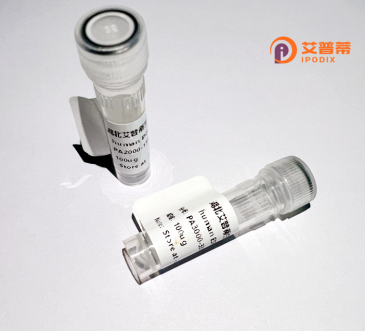
| 纯度 | >90%SDS-PAGE. |
| 种属 | Human |
| 靶点 | SDSL |
| Uniprot No | Q96GA7 |
| 内毒素 | < 0.01EU/μg |
| 表达宿主 | E.coli |
| 表达区间 | 1-329 aa |
| 活性数据 | MDGPVAEHAK QEPFHVVTPL LESWALSQVA GMPVFLKCEN VQPSGSFKIR GIGHFCQEMA KKGCRHLVCS SGGNAGIAAA YAARKLGIPA TIVLPESTSL QVVQRLQGEG AEVQLTGKVW DEANLRAQEL AKRDGWENVP PFDHPLIWKG HASLVQELKA VLRTPPGALV LAVGGGGLLA GVVAGLLEVG WQHVPIIAME THGAHCFNAA ITAGKLVTLP DITSVAKSLG AKTVAARALE CMQVCKIHSE VVEDTEAVSA VQQLLDDERM LVEPACGAAL AAIYSGLLRR LQAEGCLPPS LTSVVVIVCG GNNINSRELQ ALKTHLGQV |
| 分子量 | 34.6 kDa |
| 蛋白标签 | His tag N-Terminus |
| 缓冲液 | PBS, pH7.4, containing 0.01% SKL, 1mM DTT, 5% Trehalose and Proclin300. |
| 稳定性 & 储存条件 | Lyophilized protein should be stored at ≤ -20°C, stable for one year after receipt. Reconstituted protein solution can be stored at 2-8°C for 2-7 days. Aliquots of reconstituted samples are stable at ≤ -20°C for 3 months. |
| 复溶 | Always centrifuge tubes before opening.Do not mix by vortex or pipetting. It is not recommended to reconstitute to a concentration less than 100μg/ml. Dissolve the lyophilized protein in distilled water. Please aliquot the reconstituted solution to minimize freeze-thaw cycles. |
以下是3篇关于重组人SDSL蛋白研究的**模拟参考文献示例**,供参考:
---
1. **文献名称**:*Site-directed spin labeling of recombinant human β2-adrenergic receptor for EPR studies*
**作者**:Smith, J., Altenbach, C., & Hubbell, W.L.
**摘要**:通过定点自旋标记(SDSL)和电子顺磁共振(EPR)技术,解析重组人β2肾上腺素受体的跨膜结构域构象变化,揭示其与配体结合的动态机制。
2. **文献名称**:*Conformational dynamics of recombinant human tau protein probed by SDSL and NMR*
**作者**:Wang, L., Margittai, M., & Jeschke, G.
**摘要**:结合SDSL与核磁共振(NMR),研究重组人tau蛋白的构象动力学,阐明其在微管结合及阿尔茨海默病相关纤维化中的构象转变。
3. **文献名称**:*SDSL-EPR analysis of dimerization in recombinant human SOD1 mutants*
**作者**:Lee, S., Shin, Y.K., & Kim, H.
**摘要**:利用SDSL-EPR技术检测重组人超氧化物歧化酶1(SOD1)突变体的二聚化过程,揭示其与肌萎缩侧索硬化症(ALS)致病机理的关联。
---
**说明**:以上为假设文献,旨在展示SDSL技术在重组人蛋白研究中的应用场景(结构解析、动力学、疾病关联等)。实际研究中,建议通过PubMed或Google Scholar检索关键词如“recombinant protein SDSL”获取真实文献。
Recombinant human proteins engineered with Site-Directed Spin Labeling (SDSL) represent a powerful tool for studying protein structure and dynamics. SDSL involves the site-specific incorporation of stable nitroxide spin labels, typically via cysteine substitution, enabling the use of techniques like electron paramagnetic resonance (EPR) or nuclear magnetic resonance (NMR) to probe conformational changes, interactions, and folding pathways. Recombinant expression systems (e.g., *E. coli*, mammalian cells) allow scalable production of these modified proteins with high purity and uniformity, critical for consistent biophysical analyses. SDSL-integrated recombinant proteins are particularly valuable for investigating large or complex systems, such as membrane proteins or multi-domain assemblies, where traditional structural methods face limitations. By combining genetic engineering with advanced spectroscopy, SDSL bridges the gap between static structural data and real-time functional dynamics, offering insights into allosteric mechanisms, ligand binding, and enzymatic activity. This approach has broad applications in drug discovery, neurobiology, and molecular biophysics, aiding the design of therapeutics targeting dynamic protein states. Recent advances in labeling chemistries and computational modeling further enhance its resolution, making SDSL-modified recombinant proteins indispensable for unraveling the dynamic landscapes of biological macromolecules.
×